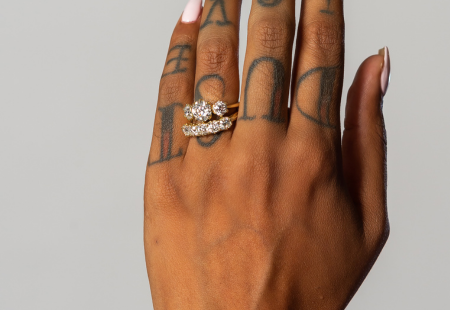Every Hera ring comes with a purity stamp indicating the purity of the metal used in the piece (14K gold, for example) as well as our maker's mark, or the Hera logo. Stamping is a standard industry practice, but if you're curious about why we do it, keep reading!
The History of Hallmarks (Purity Stamps and Maker's Marks)
Jewelers have included maker's marks inside their work throughout history for two purposes. First, like any other work of art, it's the artist's signature. Second, it's a consumer protection measure that has been required by many countries' gold assay offices for hundreds of years. These laws, such as in the UK, require both a purity stamp and a maker's mark, which ties the purity stamp to the jeweler and keeps the jeweler accountable for advertising the purity of their gold truthfully. We include these marks to ensure that our clients know we stand behind and guarantee the purity of the gold or platinum ring they have ordered. Antique jewelry collectors and auctioneers often use these marks to determine the origin and value of jewelry, so a maker's mark is also a piece of the jewelry's history.
US Legal Requirements for Hallmarking
There are various interpretations of the National Gold and Silver Marking Act of 1906 and FTC guidelines regarding purity stamps and maker's marks. One common interpretation is that it's actually illegal not to stamp a piece with a purity mark like 14K if it’s being advertised as such.
The Jewelers Vigilance Committee guide to the FTC guidelines states: “If you want to call an object ‘gold,’ you must identify its karat quality. Traditionally, that is done by marking (stamping) the piece. When you mark a piece with its karat quality, legally you must also affix the registered manufacturer or dealer’s trademark.” This means that if we include a purity stamp like 14K, we must include a maker's mark, or our logo. The FTC requires this for corporate accountability and consumer protection. With the stamp and our maker’s mark on the piece, we’re legally responsible for ensuring the ring is indeed the gold purity we advertised.
There are jewelers who interpret this law to mean that a purity stamp isn't required to be on the ring itself as long as it is included elsewhere, which would theoretically allow them not to include a maker's mark either. We don't feel totally confident in that interpretation, though; this kind of legal analysis is outside our area of expertise. As a small business, we aim to follow a conservative interpretation of the law and FTC guidelines to protect our business and our team. Therefore, we purity stamp our rings to ensure compliance and to further demonstrate our commitment to excellent quality for all of our clients.














